Key figures remember moments and lessons from the Sandusky scandal
It was quiet at the beginning of the week that changed everything for Penn State.
The morning of Nov. 5, 2011, came with a chill in the air, and a football bye week meant Penn State’s campus was unusually low key for an autumn Saturday.
By the time the Nittany Lions walked off the field of Beaver Stadium after a loss to Nebraska the following weekend, that serenity would be a memory.
A prominent, retired defensive coordinator had been arrested on charges of sexually abusing boys, dominating the national news.
A football coach with more than 60 years of service to Penn State had been terminated over the phone. A highly regarded university president no longer held his position.
A throng of media had overrun State College, chasing the dual stories of the Jerry Sandusky criminal case and the fall of the winningest major college football coach in America, Joe Paterno. The student body reacted to it all by rioting.
As the 10th anniversary of the Sandusky scandal passes, it’s a moment to look back and examine what stands out from Penn State’s worst moment. This is the story of those infamous November days, told through the memories of key individuals in and around the university who were directly impacted.
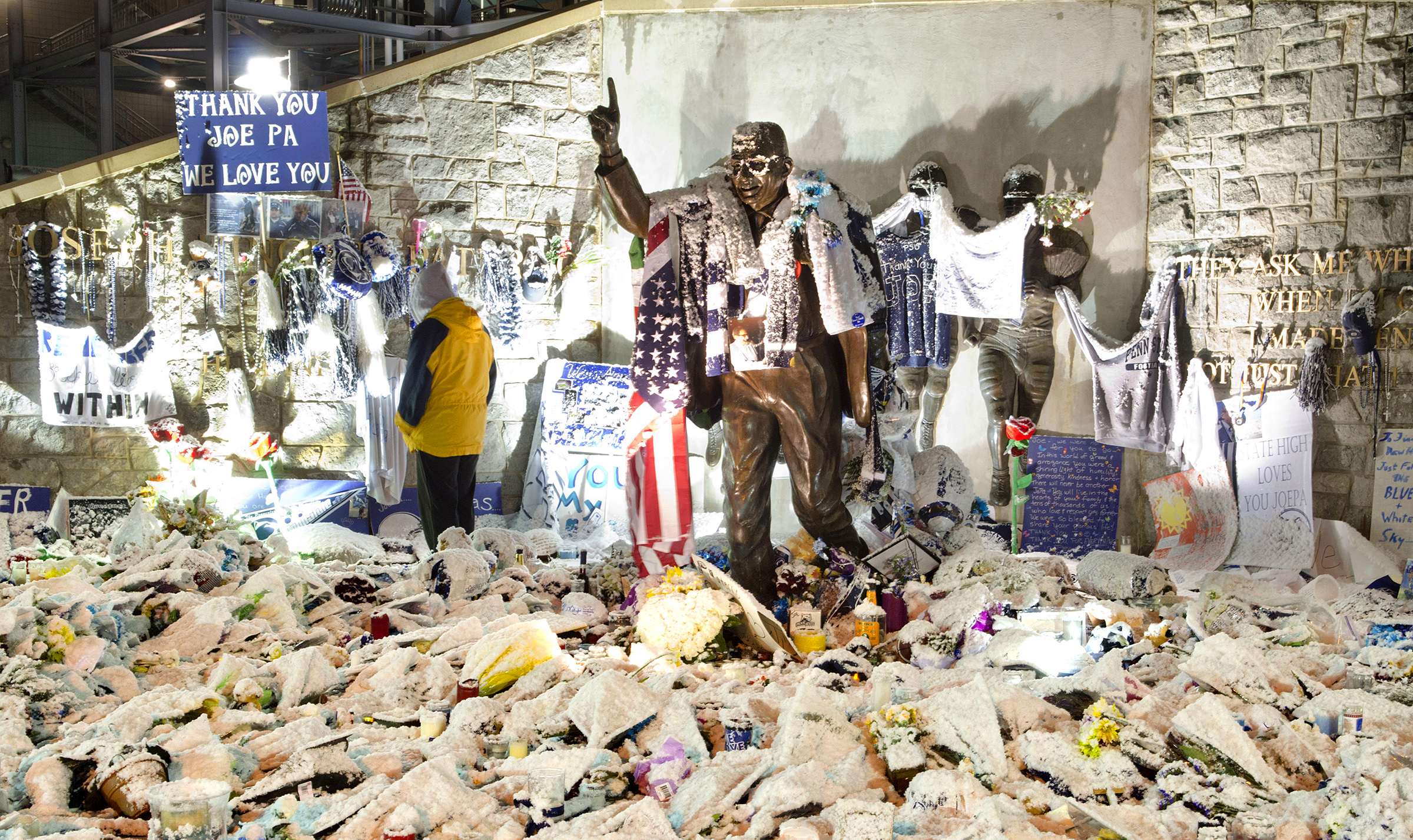
A light snow covers the statue of Joe Paterno on January 29th, 2012, a week after his death from lung cancer. Six months later the statue was removed by college officials from outside of Beaver Stadium on the Penn State campus. ~ photo by John Beale
“An Above-the-Fold Story”
While driving through Ohio on Nov. 4, Jay Paterno’s phone rang. The Penn State quarterbacks coach, and Joe’s son, was on a recruiting trip that Friday night, visiting some high schools and a playoff game. On the other end of the line, his brother, Scott, spoke in a concerned tone about the documents charging Sandusky.
“It is about to hit,” Jay recalled Scott saying. “The presentments are really, really bad.”
The younger brother sensed his family’s world was about to change, he just couldn’t tell how much.
Jay had grown up as a part of the Penn State community, riding his bike to Berkey Creamery and going to Mass on campus every week. Despite being from such a prominent family, Paterno and his siblings were kept relatively out of the spotlight. They weren’t on TV or around the field after games. When their father came home, conversations centered around school or daily life, but rarely football.
After a playing career at Penn State, Jay left Happy Valley for five years, coaching football in a variety of roles across the country. He returned in 1995 and had been on Penn State’s coaching staff for 16 years. When he got the invitation to come home, he was excited.
“It was just phenomenal,” Paterno said in a recent interview. “The things that he and I may have missed out on as father and son, I felt like I gained a lot of that back as an adult.”
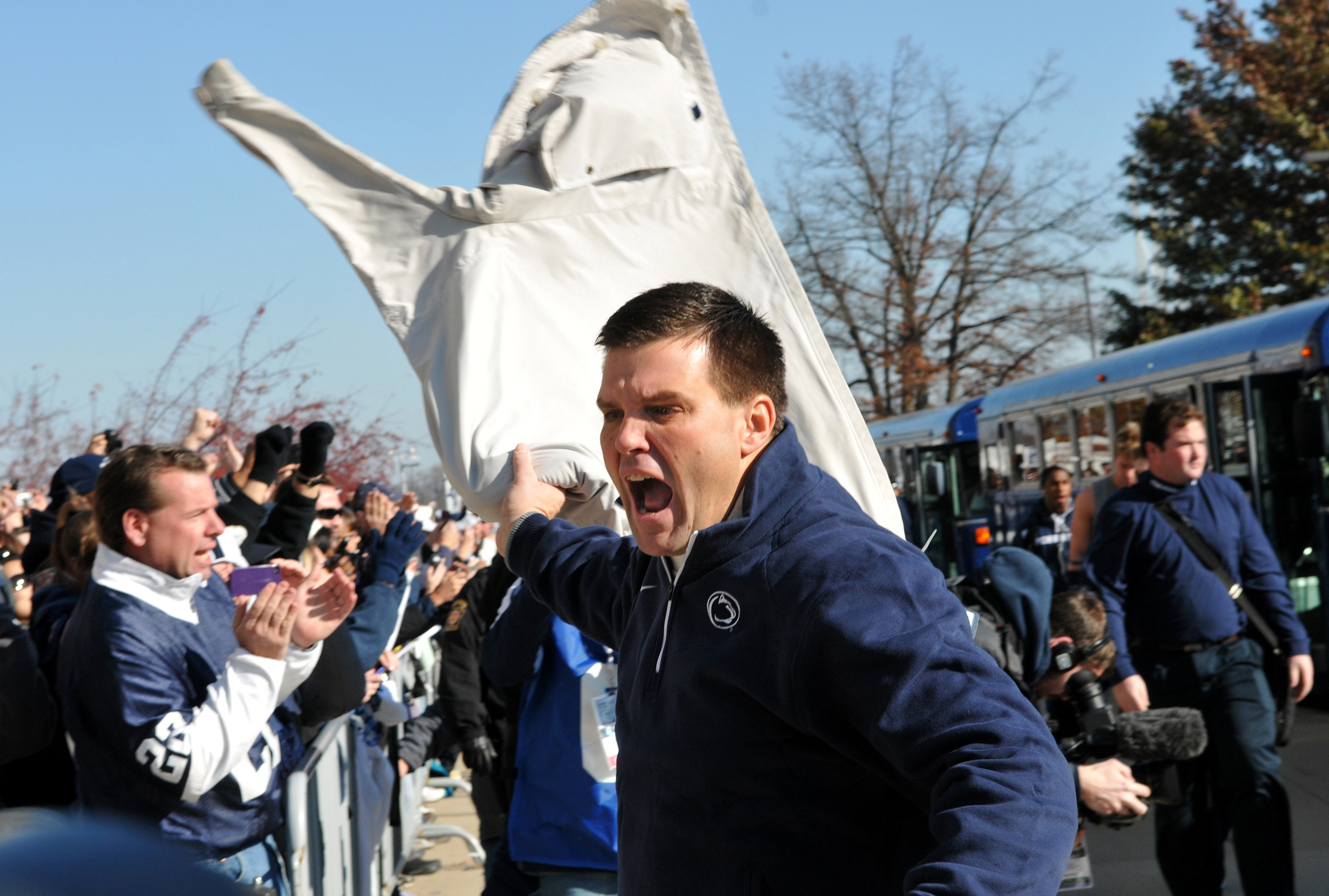
Jay Paterno gets off the team bus before a game against Nebraska at Beaver Stadium on Nov. 12, 2011. It was the first game in decades that Penn State played without his father as head coach. ~ photo by John Beale
As he made his way across the state, Paterno couldn’t stop thinking about his brother’s message. News had broken earlier that year, in March, that Sandusky was under a grand jury investigation, but prosecutors managed to keep what they were doing quiet ever since.
Jay Paterno received a call Saturday morning from Pete Thamel, then of The New York Times, asking for a comment on Sandusky’s arrest. Paterno explained that he did not fully know what was going on, as he was returning from Ohio. Thamel’s response has resonated with Paterno to this day.
“Well,” the reporter said, “this is an above-the-fold story.”
The public would hear details of the investigation later that day with Sandusky’s arrest.
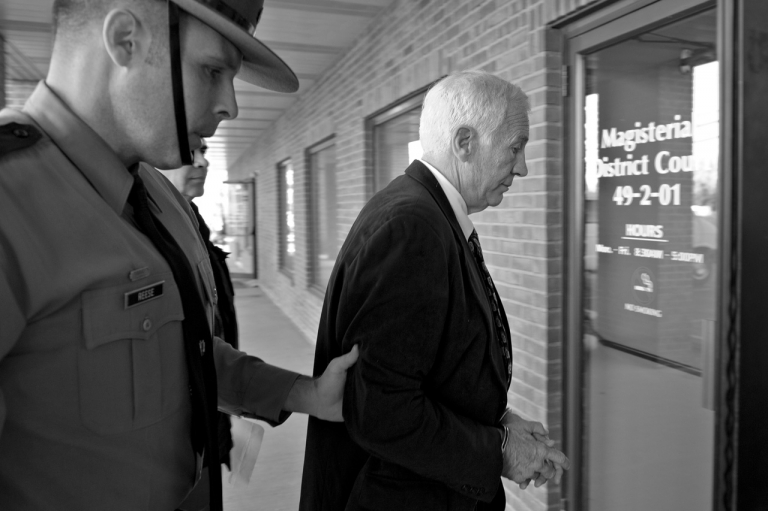
The initial charges, later expanded, accused Sandusky of serial sex abuse of children over a period of 15 years, in various locations including Penn State’s campus. He faced dozens of charges.
Even more shocking to the public, and a focus of public attention, was a 2001 allegation from graduate assistant Mike McQueary.
McQueary had shared the details of what he thought to be sexual activity between Sandusky and a boy in the showers of the football building, hearing “rhythmic, slapping sounds.” He reported the sighting to Joe Paterno, who passed it along to athletic director Tim Curley, his supervisor.
McQueary was interviewed a week later by Curley and Penn State vice president Gary Schultz, and they briefed then-university President Graham Spanier in some fashion, but police were not notified.
The national reaction was swift.
Audrey Snyder, now a sports writer for The Athletic, was a senior journalism student freelancing at the time for USA Today. She said that many major news outlets called upon students that week to help them be eyes on the ground as reporters were sent in.
“I remember walking up through campus and there were just television cameras lined up. It was unlike anything I’ve ever seen,” Snyder said. “It was just a who’s who of national reporters flocking to town and everybody is jostling for this story, but nobody really knows what is going on.”
Thamel was right. It was an above-the-fold story. Happy Valley had become the center of breaking news coverage, and Penn State was in the center of the center.
“I’m Coming to Town to Take Joe Down”
Even just a decade later, it’s hard to truly understand how important Joe Paterno was to Penn State and to college football.
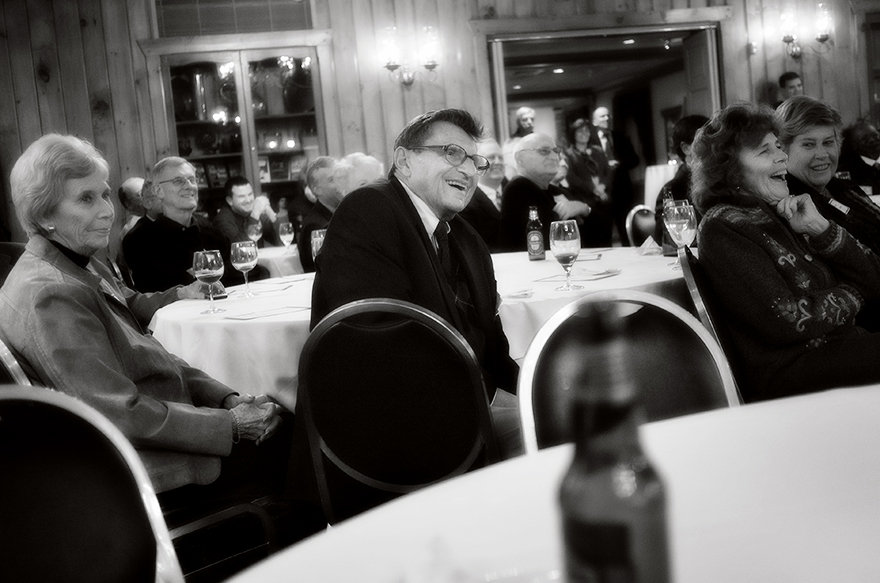
Over his 62 years on the Penn State staff, and 46 seasons as the head coach, the Nittany Lions won two national championships and three Big Ten titles. Paterno’s 409 victories established him as one of the greatest coaches in the history of the sport.
But it was more than the number of wins. It was how Penn State won, his supporters said, the right way. Paterno was famous for valuing the education of his players. Donations from he and his wife, Sue, expanded the school library. He turned down a lucrative offer from the NFL’s New England Patriots in the early 1970s to stay in the community.
He once quipped that he didn’t want to leave the college game to the “Barry Switzers and Jackie Sherrills of this world,” two coaches with a reputation for playing loose with discipline and NCAA regulations.
Quarterback Matt McGloin spent four years learning from Paterno. He said that Penn State’s coach prided himself on teaching lessons that players would use not only on the field, but later in life.
“It never got old playing for Joe,” said McGloin, who went on to spend four years in the NFL. “I did my best to try to be a sponge and soak up as much football and life knowledge as I could.”
On campus, Paterno walked to work every day and often interacted with students and faculty on campus. When his team had a breakout year in 2005 after a run of poor seasons, the number of Penn State freshmen spiked the following autumn.
“Joe continued to coach football as long as he did, not because he felt he needed to win more games but it was the window it gave him to support the university more broadly,” Spanier said recently in an interview at his home in State College. “He was very dedicated to the academic mission and fundraising efforts of the university.”
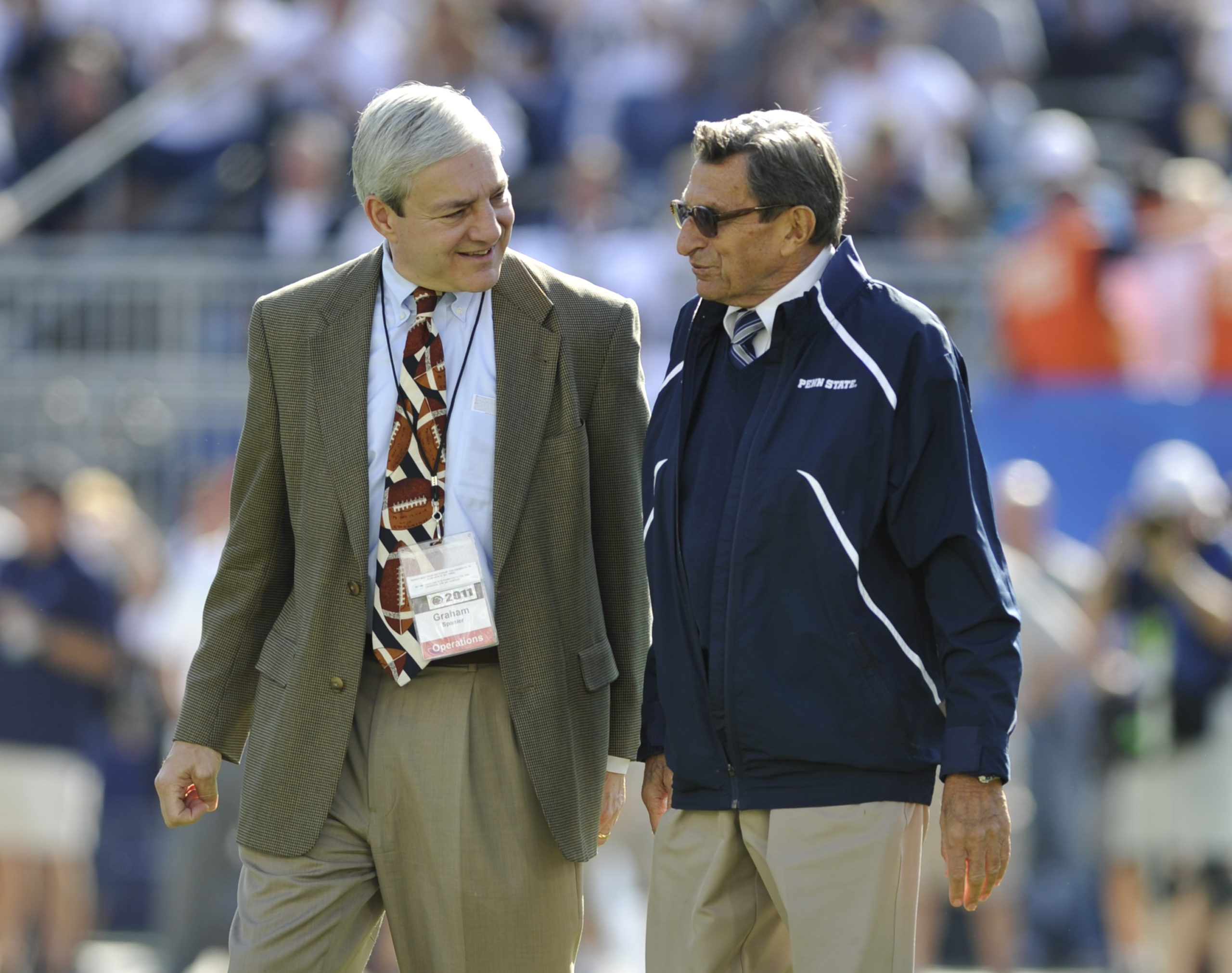
Nearing his 85th birthday before the start of the 2011 season, Paterno knew that his coaching days were coming to an end. A private signed agreement was completed the summer before the season between the university administration and Paterno, stating that he would retire at the end of the season and the coach would announce it, Spanier said.
According to Jay Paterno, his father was not looking for a farewell tour. He wanted the focus to be about the players and that season. Outside of his family, Jay said only a few people knew of his intentions to retire.
As the week after Sandusky’s arrest started to unfold, Paterno began his preparations for the matchup against Nebraska. But by Monday, Curley and Schultz had been indicted on perjury charges, only making the situation hotter.
Journalists pouring into town prepared themselves for statements from Penn State’s head coach at his weekly Tuesday afternoon news conference. Snyder recalled standing in line with dozens of journalists outside Beaver Stadium for nearly two hours that afternoon.
However, the immediate response from the university was to shut down from a public relations standpoint. The news conference was canceled, leaving scores of journalists outside Beaver Stadium now looking for their own break on the story.
Malcolm Moran, a prominent national sportswriter who served as the Knight Chair in Sports Journalism and Society at Penn State from 2007 to 2012, said that the pressure for digital content drove the media to find a story to cover.
“The need to feed the beast was clouding people’s judgments,” Moran said. The cancelled press conference “was the moment the world came off its axis. The most visible person in the university culture was mute.”
Penn State and Paterno quickly became the focus of the story. Throughout the week, hundreds gathered outside the Paterno household just off campus on McKee Street. The crowd, split between students and journalists, stood around waiting an eventual response from inside the Paterno home.
On Tuesday night, Paterno walked out barefoot in a gray Nike sweatshirt and waved to the crowd, telling the students to go to class. Snyder was there and remembered the scene vividly.
“It was just a surreal moment because here’s one of the main figures in the story, with no shoes on in his front lawn late at night, trying to console these upset students, and yet here we are as reporters and you don’t know who knew what when,” she said.
As journalists began to report on the week, the Paterno family believes some looked to take it a step further than breaking news.
“One media guy, and I won’t say who, basically said ‘I’m coming to town to take Joe down,’” Jay Paterno remembered. “What is moving the needle and creating the most clicks? Every time they put Joe Paterno in the story, it does. He became a lens for people to view the story through.”
On Wednesday morning, the elder Paterno released a statement announcing he would retire at the end of the season. In this statement, he said of the Sandusky case, “It is one of the great sorrows of my life. With the benefit of hindsight, I wish I had done more.”
It was the first big moment on an eventful day.
“You Can’t Take the University Out of Us”
A week before the lowest of lows came the highest of highs. Paterno earned win No. 409 on a snowy Saturday in Beaver Stadium. He was the all-time leader in wins at the highest level of college football.
Paterno coached from the press box that day, as he did for most of the season after sustaining hairline fractures in his hip and pelvis in a preseason collision at practice.
Also looking on from various spots around Beaver Stadium that day were Spanier, Curley and Sandusky.
Following the game, Spanier and Curley posed with Paterno and presented him with a plaque that read: Joe Paterno. Educator of Men. Winningest Coach. Division I Football.
Two weeks later, all three would be out of a job.
Similar to Paterno, Spanier was embedded in the Penn State community in a way that was uncommon for a university president.
He loved his job and kept his finger on the pulse of student life. Living in residence halls at the beginning of every school year and playing the washboard in a Dixieland band downtown were just a couple of Spanier’s quirky habits.
Spanier described his relationship with Paterno as the best it could have possibly been between a university president and head football coach. Spanier chuckled as he recalled it. “We didn’t go to the movies together, but we had a very good working relationship,” he said.
The two would recruit donors for the university, and Spanier referred to him as a great supporter who was “all in” for Penn State.
Throughout the grand jury investigation, and in a statement on the day Sandusky was arrested, Spanier had given his full support to Curley and Schultz. After their arraignments, this decision reflected poorly on the president. With tensions rising, the board of trustees wanted to manage the crisis themselves, as opposed to the university administration.
This all came to a head for Spanier around the same time Paterno announced his intentions to retire on Nov. 9. The school president handed in his letter of resignation to the board of trustees. He had made the decision the day before, he recalled, saying that although board members wished he would not quit, they respected his decision and said he would be treated well.
“It was my decision, but I’m not sure the outcome would have been any different,” Spanier said. “It became untenable for me to continue and it might have ended up that way in any case.”
Spanier has argued ever since that he was innocent of wrongdoing in the case. But he ultimately lost a protracted legal battle with prosecutors and was convicted on a single misdemeanor count of child endangerment as several other charges were either thrown out or ended in acquittal. He served a short jail term this year.
Spanier said he carries no ill will toward the university and remains a supporter of Penn State to this day, although he wishes the relationship between the two could be stronger.
“You can take us out of the university,” Spanier said, referring to himself and the Paterno family. “But you can’t take the university out of us.”
“I Can’t Tell Them What I Know”
From the first time that the Sandusky case came across the desk of then-state Attorney General Tom Corbett in 2009, he knew that it would not be pretty.
Corbett worked on the case from 2009 until he became Pennsylvania governor in January 2011. Through those two years, the Republican prosecutor searched for witnesses and resources, building a case against Sandusky. In the beginning, he did not have enough agents to work solely on the investigation. That ultimately changed over time.
It is not uncommon for active grand jury cases to remain confidential for years until the charges are made public. As Corbett began the transition from attorney general to governor, he was tasked with selecting his replacement, knowing that person would receive all of the cases he had started.
He chose Linda Kelly, whom he had worked with since the 1970s. The two had tried cases similar to Sandusky’s in the past, and his confidence in her abilities and experience made her the perfect candidate in his mind.
Because Corbett was sworn to the grand jury, he could not tell anyone about this case, so Kelly did not know about the Sandusky investigation until early 2011. She stayed with it through Sandusky’s conviction more than a year later.
At the time, the governor of Pennsylvania held a voting role on the Penn State board of trustees. As Corbett worked with the trustees, and his representatives attended BOT meetings throughout 2011, he couldn’t help but think of what was to come.
“One of the thoughts was I can’t tell them what I know,” Corbett said in an interview at his Pittsburgh office. “I would be very surprised if (the board of trustees) knew, and the reaction was clear that they didn’t.”
Corbett learned of the Sandusky charges on the radio that Saturday as he was traveling out of state. On Nov. 9, after numerous discussions among other members of the board, Corbett was asked to participate in an emergency meeting, where important decisions were being made, including the status of Paterno’s employment.
Corbett listened in on the phone from the governor’s residence, 90 minutes away in Harrisburg. He recalled that he did not vote in this meeting because he felt it would have been inappropriate, given his former job, but he shared two viewpoints just before the vote.
“Just before the vote I said, ‘Number one, I wish Joe would have done more,’” he said. “And then, number two, I said you have to remember the children.’ That was it. I didn’t tell them how to vote and in fact when the vote came I didn’t vote.”
After the conclusion of this meeting, the board of trustees announced that a news conference would be held that night at the Penn Stater hotel. What they failed to anticipate was the reaction to come from the town.
“The Scariest Situation We’ve Ever Been In”
By this time on Wednesday night, Nov. 9, news satellite trucks accompanied hundreds of journalists in State College. They made their way off of Penn State’s campus toward Innovation Park about two miles away, where many reporters and crew members sat in a state of anticipation, waiting for an announcement of massive magnitude.
Around 10 p.m., the Penn State board of trustees held its first news conference regarding the matter, four days after the charges were released.
Inside a room at the Penn Stater hotel, the media was joined by stowaway football fans who had snuck into the room. This created a mixed reaction in the room as the announcement was read from vice chairman of the board John Surma: Spanier was no longer the president of the university, and Paterno no longer the head football coach, effective immediately.
“I was just stunned,” Jay Paterno recalled. “I sat down with my wife and said ‘I don’t know if I’m going to make it until tomorrow, because if they want him out I’m pretty sure they want me out too.’”
Minutes before the news conference, Paterno had been fired over the phone as he sat inside his house just north of Penn State’s campus.
Spanier recalled that he was very disappointed that the university fired Paterno and believed that there may have been ulterior motives at stake. “I think some members of the board of trustees were very angry that he announced (his retirement) rather than letting them make the decision,” he said.
In a matter of minutes after the announcement, a crowd of several thousand furious protestors took to the streets of State College.
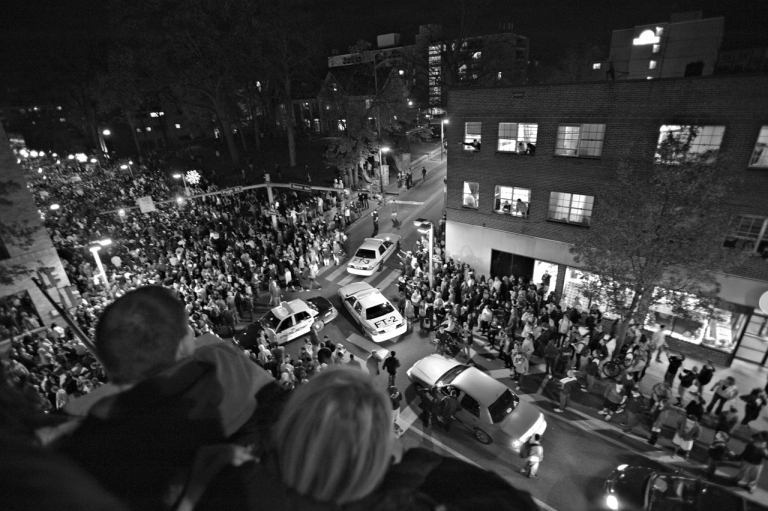
Then-captain and now State College police Chief John Gardner had been employed by the department since 1990. In his 31-plus years of service, nothing has compared to that night.
“I am not ashamed to sit here and say it was probably the scariest situation we’ve ever been in,” Gardner said.
It was not the first time the police had dealt with a student-led riot. Procedure says to allow the crowd to have some time and to simply maintain order. Police are content to let the crowd demonstrate as long as it is not violent.
This tactic would not work on the night Paterno was fired.
Police were outnumbered nearly 50 to 1. Gardner described a buzz in the air that spread through the crowd. It was atypical for student riots.
“All I can say is there was anger that I’d never seen the depths of before like that,” Gardner said.
With the crowd in excess of 5,000 individuals, “flash mob” technology was utilized, allowing students to use social media to clearly communicate better than the police could.
Gardner believed that the intense media coverage that night fueled the crowd. He recalled some journalists threw themselves into the middle of the chaos, inciting the crowd even more.
Signs and light poles were knocked to the streets. A local TV van was flipped over and set on fire. Large rocks were thrown at police officers as pepper spray was deployed on the crowd. This went on until shortly after 3 a.m. Thursday.
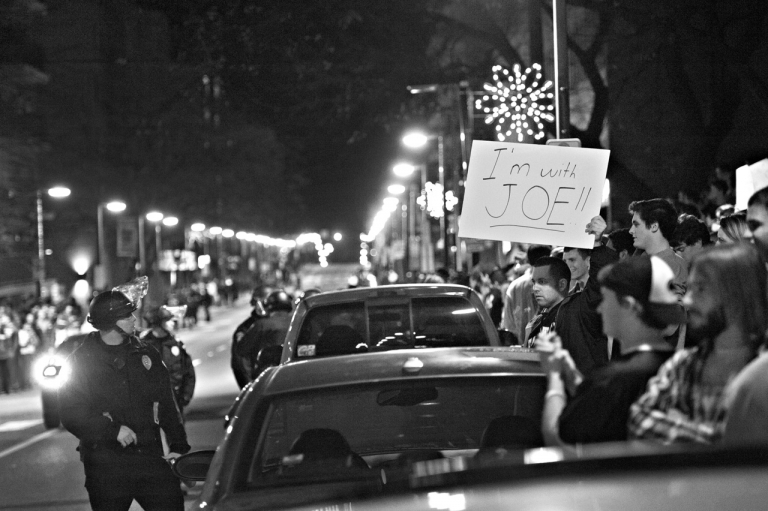
The board of trustees gave no formal warning to the police department that it was about to announce Paterno’s firing, which Gardner believes put officers at a disadvantage. The lack of notice paired with the poor timing of the incident — late at night — was described as the “perfect storm” by Gardner.
With the riots creating havoc, Corbett made the decision to go to State College. He arrived on Nov. 10 to try and get a handle on the reaction.
Corbett worked with the leaders of student organizations to host a news conference, giving the students the platform to take control of a spiraling situation. He said those students seized the opportunity better than the university could have, saying that the riots did not represent the student body as a whole.
“I was greatly impressed by the student leadership at Penn State,” Corbett said. “It was their voice that really calmed everything for that period of time and kind of brought that period to somewhat of a concluding chapter.”
“Revered Patriarch to Reviled Pariah”
Just a few hours after the riots, around 5 o’clock on Thursday morning, Jay drove over to Joe’s house. He hadn’t slept at all that night and decided to make the familiar drive early in the morning to see his father.
Jay wrestled with the thought of coaching without Joe and told him that he did not know if he could coach the rest of the season. Joe looked at him and quickly responded.
“He looked at me and said ‘You have an obligation to these players and this team. You’ve got to do your job to the best of your ability. You focus on that,’” Jay recalled. “That really helped me, but it was tough walking out of that door knowing that he wasn’t going to be coming to practice later.”
Joe Paterno spent his first football Saturday away from Penn State in over 60 years in the hospital.
Things deteriorated quickly for the longtime Penn State coach. After coughing up blood for the second day in a row, Paterno went to the hospital on the morning of Nov. 12, game day against Nebraska.
Jay recalled his sister having to walk Joe out into the garage and lay him down on the backseat of the car. She covered him with blankets to hide him from the media, got in the car and drove away.
This ruse was performed multiple times in the following days, but eventually the family announced the elder Paterno had lung cancer. He passed away in January 2012, just two months after his firing.
“You go from being a revered patriarch to a reviled pariah in a lot of people’s minds just like that,” Jay said, reflecting on those final months. “It was tough.”
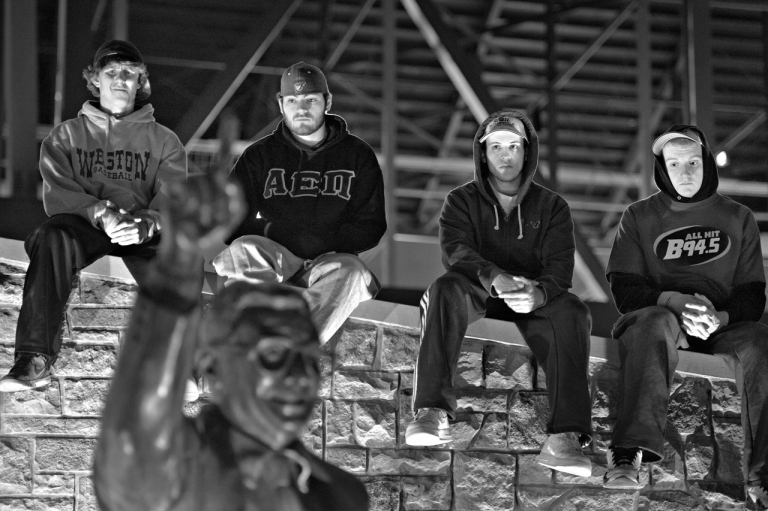
McGloin and a teammate went to the Paterno house a few days after the 17-14 Nebraska loss. It would be the last time the quarterback from Scranton would speak to his former coach.
“His concern was ‘How are you guys doing?’ It was always about us,” McGloin said. “You don’t get a lot of opportunities to see Joe in that setting. It is definitely one of the great memories that I have with Joe.”
Sandusky would be sentenced to 30-to-60 years in prison, convicted of 45 charges of sexual abuse. Curley and Schultz each would plead guilty to a misdemeanor and, like Spanier, serve jail time.
Corbett would go on to become the first Pennsylvania governor in 40 years to fail to win re-election. Although he admits there were numerous factors that affected the vote in 2014, he says his work on the Sandusky case did not help his re-election campaign.
He recalled a story from about six months after he left office. While walking through a grocery store near his house, someone in a Penn State jacket pinpointed him and quickly approached.
“He goes ‘You’re Governor Corbett aren’t you?’ I said yeah. He replies ‘We got you,’” Corbett recalled.
But, to the former governor, “It’s not about me or Penn State, it was about the children.”
“A Greater Appreciation”
In and around Penn State, feelings are still strong about the whole episode that began with Sandusky’s arrest. Those feelings also vary, depending on the people and their roles and memories of the case.
Joe Paterno helped Penn State build its foundation on a model of what was termed “Success with Honor.” His son, Jay, feels Sandusky’s crimes were just that — his own. In Jay’s eyes, his father was a good man who had a disservice done to his reputation that can never be fully reconciled.
“This story has been told so often through the lens of Joe Paterno. This was a multi-year investigation and, at the end of the day, Joe was in there for six- or seven-minutes total,” Jay said. “People have vilified a man who had 61 years of integrity. Unfortunately, they are canceling the wrong guy on this one.”
Spanier’s opinion is comparable. He says the Sandusky criminal case was portrayed in a way that led people across the country to make broad, sinister conclusions about Penn State that were simply not true.
“A lot of what was reported was not accurate, and that allowed a lot of people throughout the nation to come to conclusions that weren’t justified,” Spanier said. “(Some reporters) have since apologized to me for how they reported it and wish they could correct the record.”
Alice Pope, a current member of the Penn State Board of Trustees and a Penn State alumnus herself, has helped to bring change to the university through governance reform.
She spearheaded grassroot organizations with thousands of alumni to bring new members into the Board of Trustees that could prioritize the mission of transparency.
“We have worked really hard to make sure that the board is accountable to the public,” she said, “so that it will be a functional decision-making entity and avoid having any repeats of disastrous decisions.”
In the time since Sandusky’s case broke open, three schools in the Big Ten have had major sex abuse cases come to light. It can happen anywhere, and at any time.
Scott Berkowitz is the president and founder of the Rape, Abuse & Incest National Network (RAINN), the nation’s largest anti-sexual violence organization. When asked to reflect on the aftermath of this scandal, he recalled efforts from Penn State alumni to raise awareness about the issue sexual abuse.
Berkowitz remembered a group of alums who started a campaign called “Proud to be a Penn Stater.” It led to nearly 12,000 alumni donating to the organization over a span of a few weeks.
“They wanted folks to know that they still loved the university, but they hated what went on and wanted to do something to help make it right,” Berkowitz said. “It’s quite rare. We often see a little bit of a bump, but this was bigger than any other case we’ve seen.”
Berkowitz also said the number of boys and men using the national sex assault hotline increased substantially in the months after the story broke.Finding a positive side to a story like this is nearly impossible, but if the Sandusky scandal provided survivors with a greater willingness to step forward, Moran said, it would be one grace note.
“A greater appreciation for victims of all kinds of criminal activity and a greater understanding of what they are going through and the importance of listening to them,” he said, “that would be a very healthy thing.”
~11.5.2021
updated 12.4.2021
Wonderful article! Very thorough. A good retrospective.